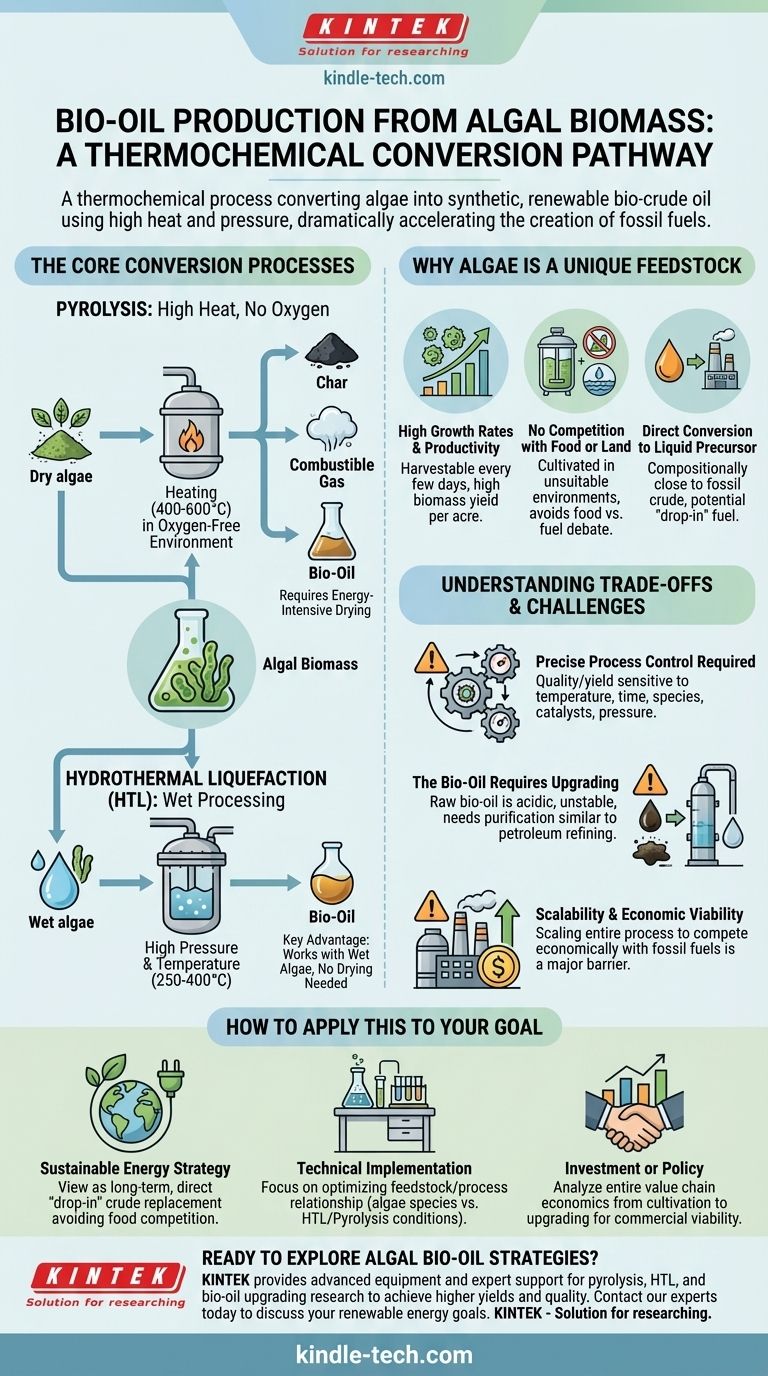In essence, bio-oil production from algal biomass is a thermochemical process that uses high heat and pressure to rapidly convert algae into a synthetic, renewable version of crude oil. This "bio-crude" or "bio-oil" can then be refined into liquid biofuels like gasoline, diesel, and jet fuel, offering a potential alternative to fossil fuels.
The core concept is to replicate the geological processes that create fossil fuels, but on a dramatically accelerated timeline. Instead of millions of years, technologies like pyrolysis and hydrothermal liquefaction convert wet or dry algae into a usable liquid fuel precursor in a matter of minutes.

The Core Conversion Processes
At the heart of algal bio-oil production are advanced conversion technologies that break down the complex organic matter of algae. The two primary methods are pyrolysis and hydrothermal liquefaction (HTL).
Pyrolysis: High Heat, No Oxygen
Pyrolysis involves heating the algal biomass to very high temperatures (typically 400-600°C) in a reactor completely devoid of oxygen.
This anoxic heating prevents combustion and instead causes the biomass to thermally decompose into three main products: a solid char, a combustible gas, and the desired liquid bio-oil.
Hydrothermal Liquefaction (HTL): Wet Processing with Heat and Pressure
HTL is particularly well-suited for algae. It uses water at subcritical conditions—high pressure and moderately high temperatures (250-400°C)—to break down the biomass.
A key advantage of HTL is that it works directly with wet algae, eliminating the need for energy-intensive drying that pyrolysis requires. This makes the overall process potentially more efficient for aquatic feedstocks.
Why Algae is a Unique Feedstock
While many types of biomass can produce bio-oil, algae present a unique set of advantages that make them a focus of intense research and development.
High Growth Rates and Productivity
Algae can grow exceptionally fast, with some species being harvestable every few days. This allows for far greater biomass yield per acre compared to traditional energy crops.
No Competition with Food or Land
Unlike corn or soy, algae can be cultivated in environments unsuitable for conventional agriculture, such as brackish water, wastewater, or closed-loop bioreactors. This avoids the critical "food vs. fuel" debate.
Direct Conversion to a Liquid Precursor
The processes used to convert algae create a liquid that is compositionally closer to fossil crude than biofuels like ethanol or biodiesel. This makes it a potential "drop-in" fuel, compatible with existing refinery infrastructure.
Understanding the Trade-offs and Challenges
As a technical advisor, it is critical to acknowledge that this technology, while promising, is not without significant hurdles that must be addressed for it to become commercially viable.
Precise Process Control is Required
The quality and yield of the resulting bio-oil are highly sensitive to the process conditions.
Factors such as temperature, reaction time, algae species, catalysts, and reactor pressure must be precisely optimized to produce a consistent and high-quality product.
The Bio-Oil Requires Upgrading
The raw bio-oil produced from algae is not a finished fuel. It is typically a dark, dense liquid that is acidic, unstable, and contains high levels of oxygen and nitrogen.
It must undergo a secondary upgrading process, similar to petroleum refining, to remove these impurities and transform it into a stable, usable fuel.
Scalability and Economic Viability
The primary challenge is scaling the entire process—from algae cultivation and harvesting to bio-oil conversion and upgrading—to a level that is economically competitive with established fossil fuels. This remains the most significant barrier to widespread adoption.
How to Apply This to Your Goal
Understanding algal bio-oil requires seeing it not as a simple solution, but as a complex technological pathway. Your perspective will depend on your objective.
- If your primary focus is sustainable energy strategy: View algal bio-oil as a long-term pathway toward creating a direct, "drop-in" replacement for crude oil that avoids competition with food production.
- If your primary focus is technical implementation: Concentrate on optimizing the relationship between feedstock and process, specifically how different algae species react to HTL or pyrolysis conditions to maximize liquid yield and quality.
- If your primary focus is investment or policy: Focus on the economics of the entire value chain, from the cost of growing algae to the energy required for upgrading the final bio-oil, as this is the ultimate determinant of success.
This technology represents a powerful method for converting fundamental biology into high-density liquid energy.
Summary Table:
| Process | Key Feature | Ideal For |
|---|---|---|
| Pyrolysis | High heat (400-600°C) in an oxygen-free environment | Dry algal biomass |
| Hydrothermal Liquefaction (HTL) | Uses water at high pressure and temperature (250-400°C) | Wet algal biomass, no drying needed |
Ready to explore how algal bio-oil production can fit into your sustainable energy strategy?
KINTEK specializes in providing the advanced laboratory equipment and expert support needed for pyrolysis, HTL, and bio-oil upgrading research. Whether you're optimizing process conditions, testing new catalysts, or scaling up your technology, our solutions help you achieve higher yields and better fuel quality.
Contact our experts today to discuss how we can support your specific research and development goals in renewable energy.
Visual Guide

Related Products
- Electric Rotary Kiln Small Rotary Furnace Biomass Pyrolysis Plant
- High Pressure Laboratory Autoclave Reactor for Hydrothermal Synthesis
- Customizable High Pressure Reactors for Advanced Scientific and Industrial Applications
- Mini SS High Pressure Autoclave Reactor for Laboratory Use
- Stainless High Pressure Autoclave Reactor Laboratory Pressure Reactor
People Also Ask
- Is pyrolysis viable? A Guide to Economic, Technological, and Environmental Success
- What are the different types of pyrolysis machines? Choose the Right System for Your Output
- What are the reactions involved in pyrolysis of biomass? Unlock the Chemistry for Tailored Bio-Products
- What are the advantages of pyrolysis technology? Turn Waste into Profit and Reduce Emissions
- What are the products of pyrolysis of biomass? Unlock Bio-Char, Bio-Oil, and Syngas



















